Turning challenges into opportunities in Tanzania
In a previous update, we introduced a major mangrove restoration project on Tanzania’s Indian Ocean coast.
Our project began with a clear objective: restore five million mangrove trees on Tanzania’s coast, supporting both biodiversity and local communities. Our ambition was high, but so was our commitment. However, reality has a way of testing even the most robust plans. Today, we’re sharing insights into the adjustments we’ve made in response to the challenges we encountered, signaling a new phase in our journey.
Pangani Village is an ancient fishing community where the Pangani River flows into the Indian Ocean. Working with our local partners at the Friends of Usambara Society (FUS), the goal is to plant 400,000 mangrove trees at this site by mid-2024.
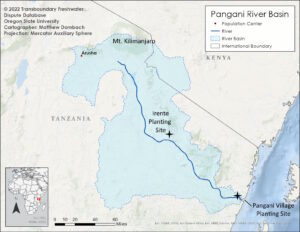
The Pangani River is a lifeline for the region’s wildlife, including fish, crocodiles, and various bird species. Its vast basin touches the lives of land and marine animals, underscoring the importance of a healthy mangrove population. These trees act as natural protectors, preserving water quality and providing habitat essential for the lower river’s biodiversity.
The health of the river directly influences the local economy: abundant fish populations support the livelihood of many people in the community.
Initial Approach Runs into Problems with Water, Damaged Roots
Over 70,000 seedlings were planted in the barren and baked Pangani08 site in 2023 using the relocation method. Healthy mangrove seedlings grow in the millions in the areas surrounding the degraded site. Relocating a few hundred thousand seedlings to nearby barren areas does not unduly stress the established areas. The initial plan was to simply relocate tens of thousands at a time from the healthy areas into the barren areas.
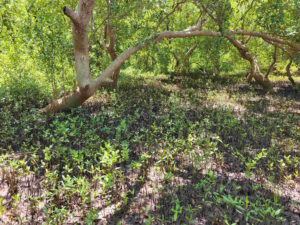
An established mangrove forest, where millions of seedlings grow like leaves of grass.
In this regard, we’re effectively using the natural forest as a nursery, thus avoiding the cost and delay of constructing a large-scale mangrove nursery project.
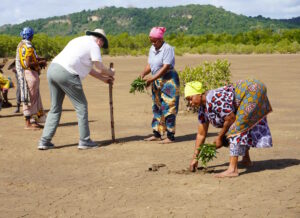
Reintroducing healthy mangrove trees to hard-baked soil requires grit and determination.
It’s a labor-intensive process to introduce the transplanted seedlings into the barren region, requiring pounding and cracking through the hard-baked surface to get through the moist and relatively loose soil layers below.
This relocation approach, recommended by the local residents as tried and true, initially showed promise. However, slowly and steadily, the transplanted seedlings began to wither. By January 2024 only ~15% of the transplanted seedlings had survived.
The root systems were possibly too damaged and stressed during the transplanting process and had difficulty gaining purchase in the new surroundings. More likely, the issue was a lack of moisture: the lower-than-normal levels of the Pangani River meant that high-tide water wasn’t reaching far enough inland to consistently nurture these trees.

The image above faces due East, about one mile from the Indian Ocean coastline. The Pangani River is on the right, and is impacted by the ocean tides. The image shows the inland reach of the most recent high tide, and the line between dry (light) and moist (darker) soils is clearly visible. Too often the moisture doesn’t even reach this far, leaving newly relocated seedlings high and dry.
Time to try another approach.
New Plan: Mangrove Nursery Expansion
Our partners from FUS are experts at nurseries, having built many in the Usambara Mountains area of the country. One of the biggest and best nurseries in the world is located in the mountain town of Lushoto, located 100 miles upriver from Pangani. This nursery is home to more than 12 million healthy seedlings, representing dozens of local species at any given time.
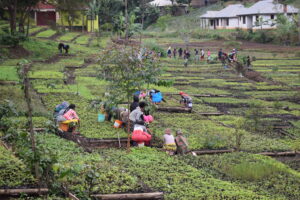
Each year more than 12 million seedlings are grown in this amazing nursery.
FUS started a small-scale experimental nursery in Pangani in early 2023 to gain experience with the various local mangrove species. The manager of this project is Rashid Khatibu, who was born and raised in Pangani Village. Rashid is a father of five and has been a fisherman for more than 20 years. In that time, he’s seen fish populations in the Pangani River and the Indian Ocean decrease by 50%. He understands the connection between the mangrove forests and a thriving local fishing industry.

There’s room to expand Rashid’s nursery to hold 400,000+ seedlings.
Rashid’s nursery is located close to the shoreline of the Pangani River, and the high tides reliably reach this location. We have learned a great deal in recent months about growing mangroves from seed in this type of environment, and as the photo above shows, there’s plenty of room for expansion.
This nursery was initially built to house only 5,000, but now we plan to increase the capacity to a total of 400,000 seedlings in the coming three months. Outplanting the young trees, with their roots still surrounded by their moist, microbial-rich, and familiar “birth soil,” will commence in June 2024.
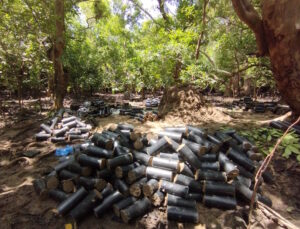
Seeds are happily growing in tubes packed with nutrient dense river mud and sand.
Looking ahead, we are focused on applying the lessons we’ve learned to improve our project’s outcomes. The challenges we’ve encountered have only strengthened our resolve and sharpened our strategies. We value the support and trust of our community and stakeholders. Join us as we move forward with renewed focus and commitment.
